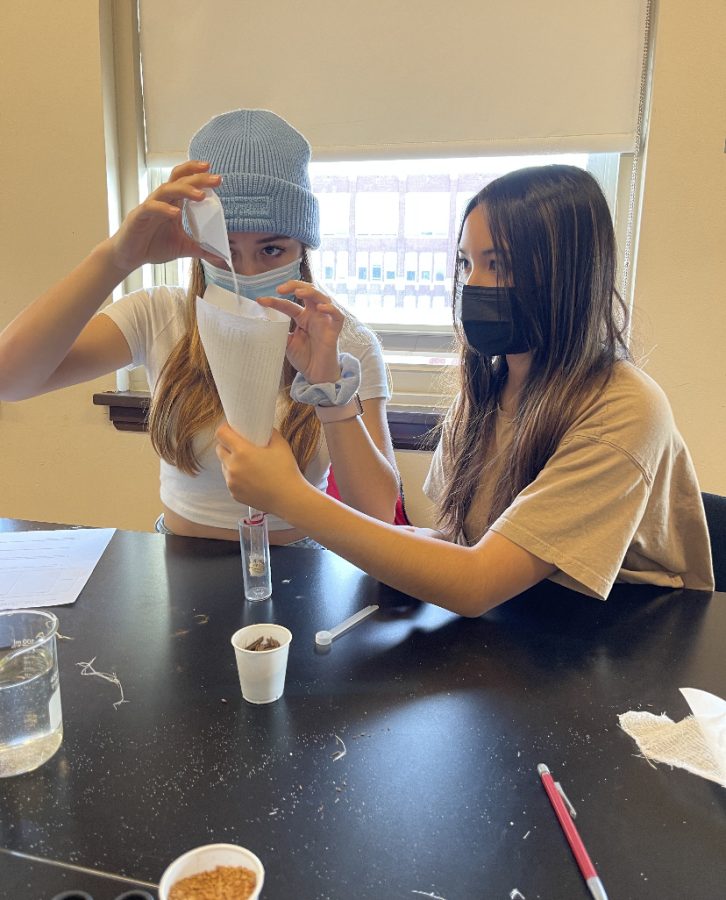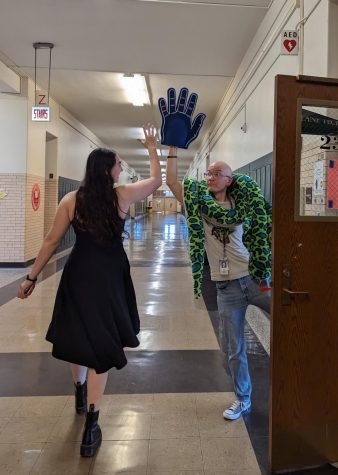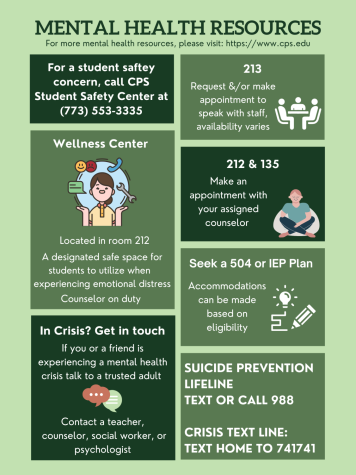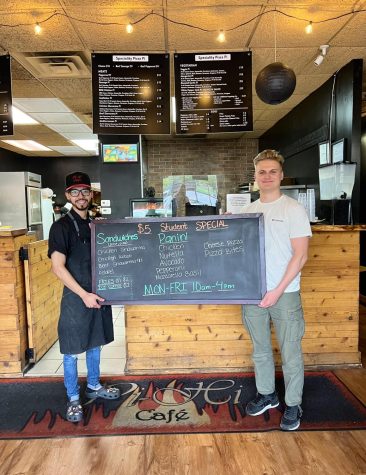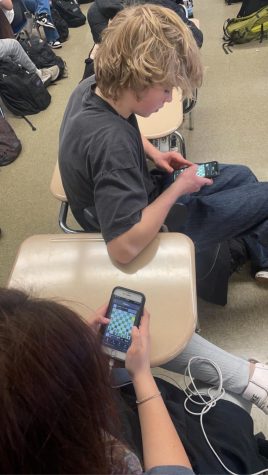The future of science is female, and that starts at Lane
An experiment from an Alpha AP Environmental Science class. Pictured from left to right: Sophomores Olivia Moroz and Erika Hanna (Photo courtesy of Olivia Moroz).
November 29, 2021
Marie Curie, Katherine Johnson, Rosalind Franklin, Mary Jackson, the number of female scientists is growing, and Lane’s very own STEM program, Alpha, provides the foundation for a career in STEM.
The Alpha program is a four-year concentration or track offered at Lane which guides students to focus on STEM (science, technology, engineering and math). In the program, students are required to take a multitude of STEM electives throughout their four years and complete the science fair project their freshman and sophomore years.
According to the Alpha department head and chemistry teacher, Lucy Young, there are currently 275 Alpha students, 160 of whom are male, 114 female and one person who identifies as non-binary. She said the sophomore and senior classes are almost equal across genders, with there being a few more males to females. But the junior class has twice as many males than females, according to Young.
Women are not only underrepresented in Alpha, but in the STEM workforce as well.
The US Census reported in 2019 that nearly half of the US workforce is made up of women, but only 27% of the people who work in STEM fields are women. This is a big jump from 1970, however, when 8% of STEM workers were women.
“Women in our society obviously wear lots of different hats. Beyond whatever job you have, [there are] so many things going on outside of that,” said Sahar Shafqat, an Alpha English teacher. “One of the reasons why maybe there’s less persistence in STEM fields is because of those life factors. Some choices that because we are women, we have to make, and that’s just unfortunately, reality.
“There’s a really dire need to have some sort of balance there, but a lot of women feel maybe that they don’t have that choice,” Shafqat said.
Shafqat, who teaches Alpha English I and II, and has taught in Alpha for the past five years, said that women often feel that they have to make a choice between career and a family once they get to a certain age. That obligation can sometimes overpower other needs that women may have.
“One of the reasons why I became a teacher is because I didn’t see a lot of teachers that looked like me growing up. So I wanted to be that for my students,” Shafqat said. “And when I did finally have a South Asian instructor, it was like, ‘oh, yeah, I can also do this.’”
The Champion conducted a survey to reach out to all students in Alpha, to find out if they had any experiences to share about their time in the program.
Many female students who took the survey had positive experiences to share. They all spoke of the love they have for the Alpha program and how they hope their participation in Alpha encourages more women to go into STEM.
Junior Linnea Holcomb, however, had a very different story to share. She said that her Alpha classes are extremely male-dominated, citing that she was one of four girls out of 28 students in her freshman year biology class, for example. She cited other experiences of underrepresentation throughout the rest of her three years at Lane in the program.
“The total gender ratio in the freshman Alpha class that year was roughly 65-35 men to women,” Holcomb wrote in an email interview. “Even this year in my Alpha English language class there is a clear majority of men in the class.
“There hasn’t been any clear sexism, there is just extremely disproportionate representation,” Holcomb wrote.
Young said this problem of gender imbalance could be because of a transition period and the pandemic.
“I think part of it could be there was a transition going on with new teachers into the program,” Young said. “Well, obviously the lockdowns and all that didn’t help us very much either.”
Shafqat said underrepresentation in Alpha may worsen as the Alpha students continue with their time in the program due to people dropping out because of the science fair requirement.
“I don’t know exactly in terms of numbers, but I feel that there’s definitely, by junior or senior year, sometimes there’s a disproportionate number,” Shafqat said. “And then people sticking to just STEM-related careers in general, professionally, there’s a disproportionate number of males versus females.”
But interestingly enough, Alpha female students are outperforming males in the science fair, the biggest competition for Alpha students.
“We do have more males, but our top finishers — every year we choose the top 10 at the December fair — and [the] top finishers will probably be, I want to say 70% female,” Young said.
Young noted that Alpha is working on their representation, specifically with minority and female students. She said Alpha specifically recruits certain students to speak at open houses for incoming and prospective freshmen.
“I’ll try to bring in more female, more diverse students into talking about the program,” Young said. “I think for anything you go into, it helps that somebody looks like you.”
Maya Wagner-Tyree is a sophomore in the program who said that by bringing in successful people who have excelled in STEM, Lane could inspire their future scientists, helping keep students in the program and address underrepresentation issues.
“I think if we got to talk to other scientists, that might encourage people to stay just because it’s kind of like if you get through this, there are lots of opportunities for you,” Wagner-Tyree said.
By encouraging women to join Alpha and most importantly, stay in Alpha, the old-fashioned rhetoric can change, according to Alpha senior Rachel Hoffman.
“I’ve definitely been like, you know if things are really hard, ‘can I actually do it?’ because I haven’t seen people do this before me until very recently,” Hoffman said. “So I think it’s important to remind women in the Alpha program that you can make it in STEM because you’re smart and you’re passionate and your gender doesn’t define what you’re allowed to be interested in.”
One group focused on educating Alpha students on minority representation in the STEM fields is the Alpha BIPOC committee. Each month, the group gives a presentation in every Alpha English class educating students about diversity among scientists who have made important contributions in various STEM fields.
Wagner-Tyree is a member of the committee and said the group’s purpose is to teach and get people excited about STEM.
“You might feel like in your class that you’re alone, that you’re different, that you don’t have anyone that looks like you, or is your heritage or your religion,” Wagner-Tyree said. “But there are people out there and we’re trying to make those people more known to the next generation of scientists at Lane.”
Another committee encouraging Alpha students to stay in STEM is the Alpha Council, which sets up events, workshops and social events meant to bridge a connection between underclassmen and upperclassmen. The council also serves to provide support to underclassmen, specifically those working on their science fair project, according to the council secretary, Hoffman.
“We basically try and keep the program connected through events and activities and make sure that all the students are getting enough support on their projects,” Hoffman said.
Because of Alpha’s history with dropouts within the program, these societies are vital to encouraging students to stay in the program.
“I think there’s definitely a concerted effort in both of those spaces to encourage everyone but in particular, for women who are interested in STEM to persist, because that’s such a big part of why those numbers decline,” Shafqat said. “Whatever those life factors are that happen or people, in general, may be losing interest or not having adequate opportunities.”
With the vast resources available at Lane, Alpha students are able to make the most of their time here and set up a successful future in STEM, according to Shafqat.
“We try to encourage all the students that are engaged in our programs, but unfortunately, there’s always issues with equity,” Shafqat said. “Given how many different resources and supports we have within the actual Alpha program, we’re able to make sure students go to a college, for example, where they know that they’ll have access to a major that they really want or a program that they’re really interested in.”
However, underrepresentation at Lane doesn’t stop with Alpha, it continues with other STEM programs in the school as well.
“I went to a robotics informational meeting where, in a packed double classroom, there were five total girls. All the guys I was sitting with thought that it was ridiculous that I thought there was an issue with that number,” Holcomb wrote. “A few days later, an email was sent out by the robotics coach saying they wanted more girls on the team.”
Young, like Holcomb, was one of the only female students in her science classes growing up.
“I think back to when I was in college, sitting in class freshman year, it was a good mix,” Young said. “Sophomore year, you started seeing the shift, and then by senior year, I’m one of two females in my physical chemistry class. At my school, nobody treated you differently. You just hung out with the boys and did your stuff, but you do notice that a lot.”
Hoffman has a few ideas on how Alpha could bring in more women and help them to stay, so by junior or senior year, classes aren’t male-dominated.
“I feel like just representation, in the beginning, is important, but then also making sure that women feel supported and they don’t feel talked down to and there’s no mansplaining — nothing like that,” Hoffman said. “It’s important to support women and make sure that those things aren’t happening.”
Although the trends point to a positive correlation for women and other minorities in STEM, there is still a long way to go and it can only go up from here. Great female scientists have paved the way for Lane’s very own budding scientists like Hoffman, Wagner-Tyree, Holcomb and so many other women in the Alpha program, and soon they will pave the way for many others.
“It is important to me to know that — if I go on to do things in STEM that I can inspire other people,” Hoffman said. “There aren’t a lot of women in STEM, [especially] 10 years ago. And to know that there are women who have made it and that’s something that I could be — a role model in a way, even if it’s not direct.
“To just show people if you can do it, because I feel like that’s one of the biggest things.”

